Title and statement of responsibility area
Title proper
General material designation
Graphic material
Textual record
Parallel title
Other title information
Title statements of responsibility
Title notes
- Source of title proper: Title based on the contents of the series.
Level of description
Reference code
Edition statement
Edition statement of responsibility
Statement of scale (cartographic)
Statement of projection (cartographic)
Statement of coordinates (cartographic)
Statement of scale (architectural)
Issuing jurisdiction and denomination (philatelic)
Dates of creation area
Date(s)
-
1863 – [199-], predominantly 1863 – [191-] (Creation)
- Creation
- Thomas Crosby
Physical description area
Physical description
182 photographs : b&w
13 prints : 12 b&w, 1 album
1 page of textual records
Publisher's series area
Title proper of publisher's series
Parallel titles of publisher's series
Other title information of publisher's series
Statement of responsibility relating to publisher's series
Numbering within publisher's series
Note on publisher's series
Archival description area
Name of creator
Biographical history
Rev. Thomas Crosby, son of Thomas Crosby and Mary Ward, was born in Pickering, Yorkshire, England on June 21, 1840. In 1856, Crosby migrated to Canada with his parents, settling near Woodstock, Upper Canada. In 1858 he joined the Wesleyan Methodist Church and became a preacher. In 1861, Crosby was working as a tanner in Woodstock when he read a call in the Methodist Christian Guardian (Toronto) for missionaries to work on the west coast. He left his job and paid his own way to Vancouver Island, arriving in Victoria in 1862.
In 1863, Crosby worked as an assistant to Cornelius Bryant at a Methodist mission in Nanaimo. In Nanaimo, Crosby met his first protégé Santana (later renamed to David Sallosalton) who joined Crosby in his efforts. Crosby and David lived and worked together. David was well known for his “Steamboat Whistle Sermon” but passed away in 1873 at the age of 19 from tuberculosis. In 1869, he was moved to the missions on the lower mainland, where Chilliwack was his home base. His success was rewarded in 1871 with ordination to the ministry in the Wesleyan Methodist Church in Canada. In the winter of 1873–74, Rev. Crosby toured Ontario to raise funds for missions and to search for a wife.
Emma Jane Douse, daughter of John Douse and Eliza Milner, was born on April 14, 1849 in Cobourg, Ontario. Her father, John Douse, had emigrated from England in the early 1830s to convert the Six Nations, and by Emma's birth in 1849 was a highly respected Methodist minister in Ontario. Emma trained at Hamilton's Wesleyan Female College, an institution offering higher learning for women in literature and classics. After completing her education, Emma became a teacher at Wesleyan Female College. In late January 1874, Rev. Crosby spoke at Emma’s College about supporting the missionary effort. Short weeks after meeting Rev. Crosby, she wrote home to her mother and expressed her desire to travel with him to British Columbia. Rev. Crosby and Emma married on April 30, 1874 in Cobourg, Ontario.
Following their marriage, Rev. Crosby and Emma traveled to Fort Simpson (from 1880, known as Port Simpson) near present day Prince Rupert at the invitation of the Tsimshian people. For the next quarter of a century they lived among the Tsimshian people, whose territory stretches between the Nass and Skeena rivers. Rev. Crosby and Emma set up schools and boarding homes for the Tsimshian children. Rev. Crosby and other missionaries encouraged single-family homes over multi-family homes and patriarchal succession over matrilineal family concepts. In 1880, a village council was established to replace native forms of government and Rev. Crosby acted as head of the council. In 1876, a large frame church was completed to symbolize Rev. Crosby’s efforts. During his tenure there were major revivals, each lasting several months, in 1874–75, 1877, 1881–82, and 1892–93.
In addition to his work at Port Simpson, Rev. Crosby established an itinerancy system along the coast from Bella Bella in the south to villages along the Nass and Skeena rivers in the north. It frequently required up to 1,000 miles of travel per year and was initially served by canoe. In November 1884, the mission acquired a ship, the Glad Tidings.
Rev. Crosby and Emma had seven daughters (Jessie, Grace, Ida Mary, Gertrude Louise, and three others) and one son (Thomas Harold). The mortality rate among the Tsimshian was high, and four of his daughters died at Port Simpson, three of them from diphtheria in 1885 and 1886; Emma was also in poor health.
In 1894, Rev. Crosby was appointed superintendent of Indian missions in British Columbia for the Methodist Church. Rev. Crosby and his family left Port Simpson in 1897 for Victoria, where he also assumed the chairmanship of the British Columbia Conference. His health was beginning to decline, and he suffered especially from a growing problem with asthma. From 1899 to 1907 he ran the missions at Sardis and Chilliwack; he then retired to Vancouver. Rev. Crosby became well known for this missionary work. He was superannuated in 1907 and moved to New Westminster. In failing health, he moved to Vancouver and passed away January 13, 1914; his wife Emma, passed away on August 11, 1926 in Sidney British Columbia.
Thomas Crosby is the author of David Sallosalton ([1906?]), Among the An-ko-me-nums, or Flathead tribes of Indians of the Pacific coast (1907), and Up and down the North Pacific coast by canoe and mission ship ([1914]), all published in Toronto.
Custodial history
Scope and content
Series consist of loose photographs, a newspaper clipping, photomechanical prints, and one photomechanical print album produced and collected throughout Rev. Crosby’s personal and missionary life, including portraits and group photographs of aboriginal individuals and/or missionaries, photographs of churches, schools, homes, hospitals, and other buildings, and aboriginal cultural and ceremonial objects (artifacts and curios). In addition, photographic events include carvings, church congregations, gathering of aboriginal children from residential schools, weddings, and funerals. Geographic locations depicted in the photographs include (but are not limited to): Chilliwack, Cultus Lake, Fort Essington, Fort Rupert, Fraser River, Greenville, Gold Harbour, Massett Village, Naas River, Port Simpson, River Inlet, Skidegate (Haida), Yale, and Vancouver Island (Nanaimo, Victoria) all in British Columbia; as well as, Whatcom County Washington, USA; Fort Wraugh, Alaska; Port Chester, Alaska; Montreal, Quebec; Norway; and Labrador. Series includes photographers and photograph studios such as Noah Shakespeare, Richard & Hanna Maynard, Carlo Gentile, J.G. Parks, Thos. E. Perkins, Geo Rirton, B.F. Howland & Co., J.M. Jacobsen, Wadds Bros., N. Caple & Co., Hugill, R.Z. Tashiro, Butcher & Co., Brooks, Skene Lowe, Nathan Joseph & Co., and S.A. Spencer. Photographers Carlo Gentile (whose Victoria studio was purchased by Noah Shakespeare) and Frederick Dally (whose negatives were partly acquired by Richard & Hanna Maynard) may also be included but unidentified. Series includes photomechanical prints, albumen prints, cabinet cards, carte-de-visites, gelatin printing-out papers, gelatin developing-out papers, a ferrotype, stereograph prints, and other unidentified print types.
FILE LIST: (with box-folder number, title, and dates)
1-1: Personal and missionary photographs – portraits (and ferrotype), ca. 1860
1-2 : Missionary photographs – reproductions, [199-]
1-3 : Missionary photographs – stereograph cards, 1863 – [191-]
1-4 : Missionary photographs – totem poles and artifacts, 1863 – [191-]
1-5 : Missionary photographs – photomechanical, 1863 – [191-]
2-1 : Personal and missionary photographs, 1863 – [191-]
2-2 : Missionary photographs – artifacts, 1863 – [191-]
2-3 : Missionary photographs – glad tidings, 1863 – [191-]
2-4 : Missionary photographs – Alaska, 1863 – [191-]
2-5 : Missionary photographs – Bella Bella, B.C., 1863 – [191-]
2-6 : Missionary photographs – Chilliwack, B.C. and Cultus Lake, B.C., 1863 – [191-]
2-7 : Missionary photographs – Hazelton, B.C. and Kispiox, B.C. ,1863 – [191-]
2-8 : Missionary photographs – Mission, B.C. and River Inlet, B.C., 1863 – [191-]
2-9 : Missionary photographs – Port Essington, B.C., 1863 – [191-]
2-10 : Missionary photographs – Port Simpson, B.C., 1863 – [191-]
2-11 : Missionary photographs – Vancouver Island, B.C., 1863 – [191-]
2-12 : Missionary photographs – Washington, USA, 1863 – [191-]
2-13 : Missionary photographs – Naas River, B.C., 1863 – [191-]
2-14 : Missionary photographs, 1863 – [191-]
Notes area
Physical condition
Immediate source of acquisition
Arrangement
No original order, the materials were arranged by the Archivist with assistance from MOA Curator, Bill McLennan. Materials are arranged by content and where appropriate by medium.
Language of material
Script of material
Location of originals
Availability of other formats
Restrictions on access
Terms governing use, reproduction, and publication
Finding aids
Associated materials
The Museum’s General Photographs Collection contains related images. This includes (but not limited to) five duplicated Rev. Crosby images from Mrs. R.T. Hager, with the following reference numbers: 2005.001.042 1.42; 2005.001.043 1.43; 2005.001.070 1.70; 2005.002.117; and 2005.002.118. In addition, this includes (but not limited to) eleven duplicated images from the Maynard Photo Studio in Victoria, with the following reference numbers: 2005.001.045 1.45; 2005.001.059 1.59; 2005.001.060 1.60; 2005.001.061 1.61; 2005.001.066 1.66; 2005.001.067 1.67; 2005.001.073 1.73; 2005.001.077 1.77; 2005.001.078 1.78; 2005.001.079 1.79; and 2005.001.080 1.80.
Accruals
No further accruals are expected
General note
Predominant dates are 1860’s – 1910’s. The dates are estimated based on the photographic print processes and Rev. Crosby’s biographical sketch. The enlarged-reproduced photographs are not known with certainty but are estimated to fall in the decade of the 1990’s.
Physical description
Includes: 168 photographs, ca.3 postcards, 11 reproductions, 12 photomechanical prints, and 1 photomechanical print album.
Conservation
Following the Museum’s pest mitigation policy, the materials underwent short-term freezing. The ferrotype photograph was isolated for a short-term period and did not undergo short-term freezing. Two photographs (folder 1-5, photograph 10/10; and folder 2-6, photograph 1/5) underwent conservation treatment to remove an unidentified metallic substance that was adhered to the reverse side of the photograph.
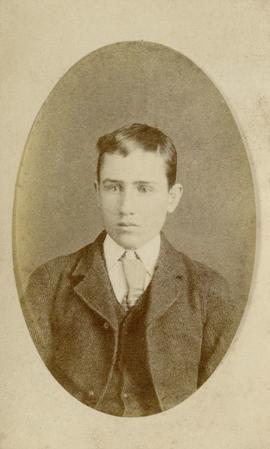
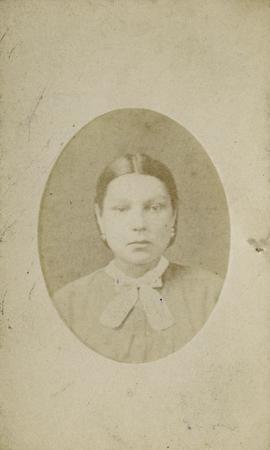
![[Portrait of] Sarah Shee-at-ston](/uploads/r/null/9/f/a/9fa20b8378bbe9ea16cdd4d3a8fe258fe7d597eb4c68b534f87ffdd8e3a854d6/a039279ac_142.jpg)
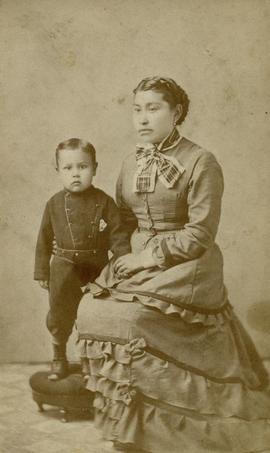
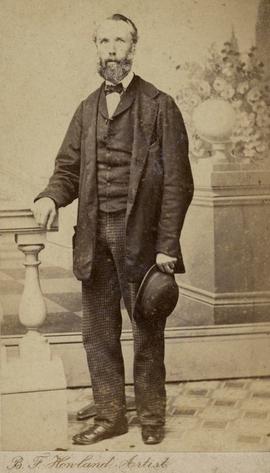
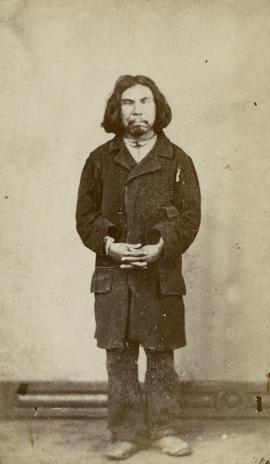

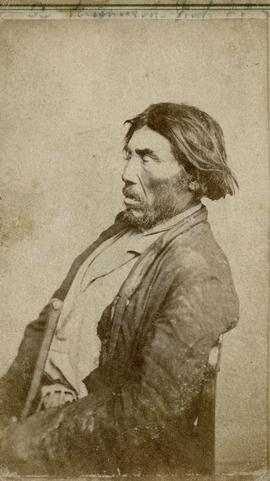
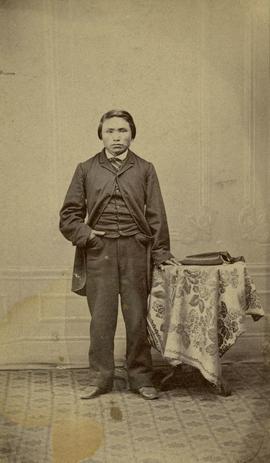

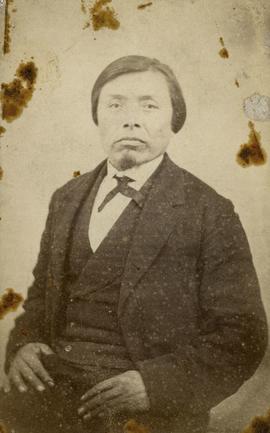
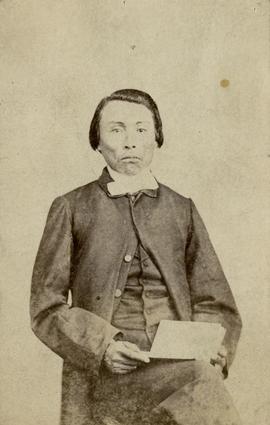

![[Portrait of doctor's wife]](/uploads/r/null/2/c/b/2cbdbf9bd42bd0e327b017af67274459ab6adb0b5c84953fc83bdb73b04350d6/a039290ac_142.jpg)
![[Portrait of woman in blanket]](/uploads/r/null/5/0/f/50fcfd5122359d2482ea74177fa01bca90d72dd9161b5cf8f6d055b3f22ac07d/a039291ac_142.jpg)
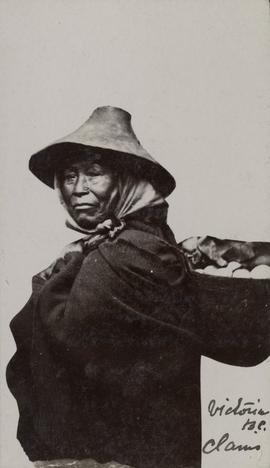
![[Portrait of man seated with cane]](/uploads/r/null/c/c/a/cca1eb067aea8cb961d077ca52f28a0975a75d282ffc1339a63fbc6bbdb1b02f/a039293c_142.jpg)
![[Portrait of woman seated on tile floor]](/uploads/r/null/4/2/2/422d87b0d18cd5499ad9772ac9c6d4ca9a84dbd262f9f64e54c1e5688857a095/a039294ac_142.jpg)

![[Fort Rupert woman wrapped in blanket, B. C.]](/uploads/r/null/1/d/4/1d4145e729fe795bcfc52c65e4eb128a13368dbee7109b66f1c31c7a693a1bf6/a039298ac_142.jpg)